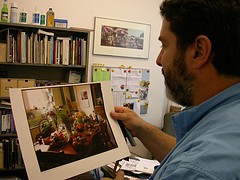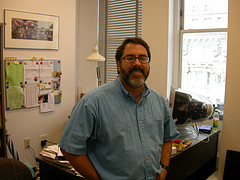
Harris Fogel in his office, June 23, 2006
[Ed. Note: This post has been updated to clarify the information about led monitors and silver digital prints. Thanks, Harris, for the clarifications.]
I met Harris Fogel on June 23 in his office on the 15th floor of the University of the Arts’ Terra building. I’d previously met Fogel, photographer, teacher and the outgoing-Chair of the Media Arts Department, in 2005 when I covered the Arthur Tress exhibit in Media Arts’ two galleries, Sol Mednick and 1401. Fogel, who runs the galleries (and will continue to do so after stepping down as chair) is an energetic guy with sense of humor that underlies a serious interest in every aspect of the world, but especially every aspect of photography, electronics, technology, internet and media subjects. He’s a chatterbox and one who’s also able to flow effortlessly from topic to topic.
Our conversation started at his office, when Fogel charged in late and all apologies with his son, Thomas, in tow. Thomas, a middle-schooler, is a blonde mini-me version of Harris’s energetic, media-obsessed self.
Thomas kept wanting to rush off to try out a new computer game on one of the department’s big computers in another room. Harris wanted Thomas to linger a bit. I milled around as Harris and Thomas negotiated and somehow amidst all the “Can I go, now?” and “No please wait” a new topic came up – the internet radio station Mac Edition Radio that they both work on (Harris is the founder and Thomas reviews computer games). Since I knew nothing about anything having to do with online radio and since Thomas was eager to get his hands on any computer, the compromise was that he’d show me the Mac Edition Radio site right there in Harris’s office while the prof was handling his inbox. It was a great management decision.
Like I said, Harris started the radio website. He also manages it, and does the major interviews with technology gurus that appear there. And Thomas reviews games. Here’s a review Thomas wrote of a game called Call to Duty 2. As an aside I’ll mention that throughout their negotiationThomas kept calling his dad “Sir,” as in
Harris:“Thomas, wait a minute,”
Thomas: “Yes, Sir.”
And while I didn’t ask I assumed the term was an endearment between two tech-savvy guys, one of whom is playing a fair number of army war games on the computer (Yes, Sir, moving into sector 5 to engage the target) and the other who has to make some Generalissimo-like decisions regarding his kid. It was kind of sweet.
Summer in the Media Arts Department
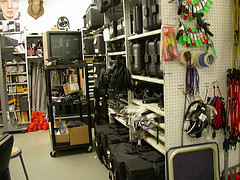
Media Arts dept. equipment room, cables and cameras and tape and microphones and everything else.
It was high summer at the art school and the department seemed deserted. But Fogel said that summer is busy time for them. Among other things, they were planning to have their first booth at a major technology show – something that required planning and negotiating.
HF-I’m stepping down after nine and a half years as chair of Media Arts. Traditionally people are not supposed to be chair that long. Most are chair for 6 years.
R-Is it a large department?
HF- The department grew so large. There are 40-44 total faculty, part time and full time. (here’s the photography faculty page at Uarts’ website.) We have almost 300 majors in photo, film/digital video and animation. It’s been gradual growth.
R-How many photography majors?
HF-In photography we have 44 seniors (around 125-150 majors). The last student show was at the Icebox. Where else can you show all that work?
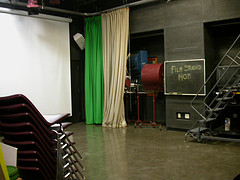
Film studio, 14th floor of the Terra building
R-Who’s taking over the chairmanship?
HF- Karl Staven is the new chair. He’s an animator. This is the first time that the chair is not a photo person. I’ll be coordinator of the photo programs and will run the galleries.
R-Tell me about the program
HF-We’re one of the best-known photo programs in the country. If you want to study Gum Bichromate printing, etc. it’s in printmaking and you can learn it here. This year we’re going to have a booth at Siggraph. In fact you can sign up for it too. Today’s the last day to register.
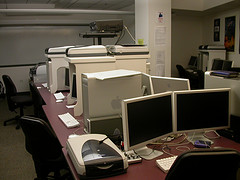
media lab
R-What’s Siggraph?
HF-Siggraph stands for Special Interest Graphics Group /ACM (Advanced Computing Machines). It’s the oldest conference on computer art and design. This is the first year Uarts will have a booth. It’s also a major trade show. People use it for recruitment.
R-Who’s manning the Uarts booth?
HF-Me, Karl, Rod McCormick, he’s a sculptor, Stephen Jackett, he’s in animation. In Sculpture, they have what they call the Digital Forge. Siggraph has grown a bit centered around animation. Siggraph is 35 or 36 years old. I’ve been going for ten years or more. (Hear his interviews with tech gurus from the floor of Siggraph). It was started by a wonderful weird group of scientists, mathematicians, artists, designers, photographers, animators, Industrial Light and Magic people, Pixar people, people who wrote Photoshop. All sorts of people who are interested in the arts and technology. . There’s a wearable technology session. One of my favorites was an outfit that changes with the temperature of the room or in response to body heat (like when your loved one comes in and your heartbeat goes up). It’s all volunteers and there are student members.
We would love to grow the animation and film/ digital video department. We will be helping to recruit new students.
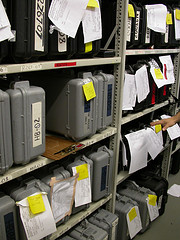
equipment room–cameras
There’s always an emerging technology room. You see things there before you see them at MacWorld or on store shelves. For example, the old cathode ray tube monitors make light themselves so you can adjust the color of that light. On a flat panel monitor the backlight is fluorescent and it’s color temperature is fixed. (you can’t control it). Then 4 or 5 years ago I heard a paper about light emitting diodes (leds) being used for the backlight in LCD monitors in the emerging technologies booth. They can trigger a range of tonalities and color temperature, so you can actually calibrate them. And last year at MacWorld NEC had the first commercial LED backlit monitors. With light pipe type design in the back, so you could calibrate the monitor. It was the same thing the people at Siggraph knew about four-five years ago….My hunch is it’s the future standard – leds will have it.
Interest in Technology – and art
R-so how did you get so interested in technology?
H-My mother took me to Cal Tech Saturday Science Program. I took courses there in science all through junior high and high school. I took programming courses in college. But I didn’t own a computer in college. I knew it would be my obsession (computers) and I wanted to be in the world of rock climbing too. But I got back into it later.

equipment room — tripods
R-So where did you go to college and what did you major in?
H-I have art degrees. BA from Humboldt State U and MA from NYU.
R- And then you got back into the technology?
H-In the world of publishing. I learned Ready Set Go and Photoshop. My uncle owned an industrial design firm and did trade show things. Very techy and very architectural. I worked for him. I also did photo restoration. Then I was a “Work Scholar” at Aperture (ie an intern).Then I worked at California magazine and we ran Pagemaker. My wife worked at Emory U. and is a whiz with Ready Set Go and QuarkXpress. So I guess we have technology in our systems!
R-You don’t seem unhappy being in the world of technology now.
H-You have a Faustian bargain. Either you’re the expert and help everybody. Or you don’t and you have to get (other) people there to help everybody.
Maturing Technology and the Emergence of Ideas
R-Talk a little about the galleries you run.
H-As gallery director I’ve seen a lot. We’re finally seeing digital work that’s not about the digital. We used to see portfolios and say “Oh, he used the gradient tool” or “she used this (Photoshop) tool.”
R-In other words the technology was all you saw and it was an impediment to seeing the work.
H-And now there’s a maturity level of an idea.
R-The technology is advancing and maybe people’s familiarity with it allows those ideas to rise. And then there’s the printing…that’s another area.
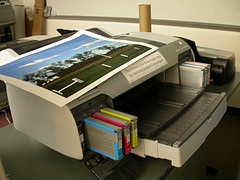
New Epson printer in the media lab. Sign says use matte paper only, not glossy.
H-The photo store Calumet (a national chain) near Home Depot on Delaware Ave. sponsored a conference at Art Center in Pasadena on silver…what is its role, etc. in the digital age. This is the first year you have ink jet paper that simulates silver. Innova a local paper company has brand new glossy paper. It’s similar to air dried glossy paper. And Epson’s 4800 (printer) from last year? It’s the first printer off the shelf to give you good black and white prints. They have 3 greys (inks) built in. And now Canon has matched them. The problem is it’s hard to capture in digital black and white what is in film black and white. But now there are tools.
R-How about the scanners?
H-Scanning is an art form unto itself. I went on a sabbatical to study scanning. At Ucross Foundation, Wyoming. I worked with lasersoft silverfast.
Here’s a story for you. There’s a Press Club in England and they wanted silver prints. They had black and white photos and worked with a (Light-Jet) laser photo printer. To print on normal black and white paper, the laser printer had to turn off two lasers, which wasn’t very good and would shorten the life of the printer. So Ilford, the paper manufacturer did a special run of paper that limited the sensitivy so that all three lasers could be used without a problem, and the resulting prints were gorgeous, traditional silver prints, but printed digitally. There’s a
Photo District News writeup. (Ed. Note: I looked for it but sorry I couldn’t find the article…Here’s news about a Silver Conference. Part 2 of this interview is here.)


